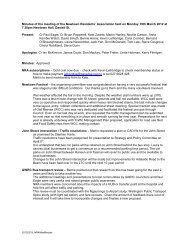Draft Town Belt Management Plan - Wellington City Council
Draft Town Belt Management Plan - Wellington City Council
Draft Town Belt Management Plan - Wellington City Council
You also want an ePaper? Increase the reach of your titles
YUMPU automatically turns print PDFs into web optimized ePapers that Google loves.
8<br />
• A weed-control programme for the <strong>Town</strong> <strong>Belt</strong> targets, in particular, old man’s<br />
beard, banana passionfruit and climbing asparagus<br />
• Revegetation of 27 hectares with native ecosourced plants.<br />
7. The managed vegetation on the <strong>Town</strong> <strong>Belt</strong> has been gradually changing from pine trees to<br />
native forest. Over 26 hectares of exotic trees (mainly pines) have been removed and areas<br />
replanted with native species in accordance with the <strong>Town</strong> <strong>Belt</strong> <strong>Management</strong> <strong>Plan</strong>.<br />
Places where exotic trees have been replaced include:<br />
• Te Ahumairangi Hill<br />
• Telford Terrace (above Oriental Bay)<br />
• Finnimore Terrace (in Vogeltown)<br />
• Berhampore Golf Course<br />
• Owen Street (in Newtown).<br />
1.5 Other relevant policies and plans<br />
Other plans that give guidance in the development of this plan are listed below:<br />
<strong>Wellington</strong> towards 2040: Smart Capital<br />
<strong>Wellington</strong> <strong>City</strong> <strong>Council</strong>’s vision for <strong>Wellington</strong> is focused on the future development of the city<br />
over the next 30 years. It builds on <strong>Wellington</strong>’s current strengths, acknowledges the challenges the<br />
city faces now and over the medium to long term, understands the changing role of cities, and is<br />
informed by <strong>Wellington</strong>’s communities. The vision is supported by four community outcomes<br />
based on the city’s competitive advantage. These are: eco-city; connected city; people-centred city<br />
and dynamic central city. These goals are central to the <strong>Council</strong>'s Long Term <strong>Plan</strong> 2012–2022.<br />
Central <strong>City</strong> Framework (2011)<br />
This is a spatial structure plan that provides overall context, direction for future planning,<br />
coordination, prioritisation and assessment of key city projects. The resulting central city open<br />
space strategy has 10 key elements, and there are two that specifically relate to the <strong>Town</strong> <strong>Belt</strong>:<br />
• Big space links: There are large open areas that can play an improved role in the<br />
provision of open space in the city. Primarily these are the <strong>Town</strong> <strong>Belt</strong> and waterfront.<br />
Improving the links to these from the city area – and providing additional amenities within<br />
these large open areas – will enable increased use.<br />
• Cross-valley links: The greening of city streets with ‘urban forest’ across the valley will<br />
enhance urban ecology and reduce the hardness of the city-scape. This will also provide<br />
corridors across the valley to join the town belts and enhance accessibility.<br />
Capital Spaces – Open Space Strategy for <strong>Wellington</strong> Te Whanganui-a-Tara<br />
This strategy was developed in 1998 and provides directions for an integrated approach to<br />
managing the natural and recreational environment, including recognising important landscape<br />
features. The <strong>Town</strong> <strong>Belt</strong> is part of the ‘Inner Green <strong>Belt</strong>s’ open space:<br />
“a series of green belts or corridors, rich in ecological, recreational and heritage values,<br />
which weave green open space through the city, containing and identifying the suburbs and<br />
connecting other open spaces”<br />
Capital Spaces is currently under review.<br />
Biodiversity Action <strong>Plan</strong> (2007)<br />
The Biodiversity Action <strong>Plan</strong> coordinates the <strong>Council</strong>’s biodiversity activities and identifies local<br />
priorities and actions for biodiversity. Biodiversity activities include pest control, revegetation<br />
planting, and partnerships with other organisations and groups.<br />
<strong>Draft</strong> <strong>Town</strong> <strong>Belt</strong> <strong>Management</strong> <strong>Plan</strong> October 2012





